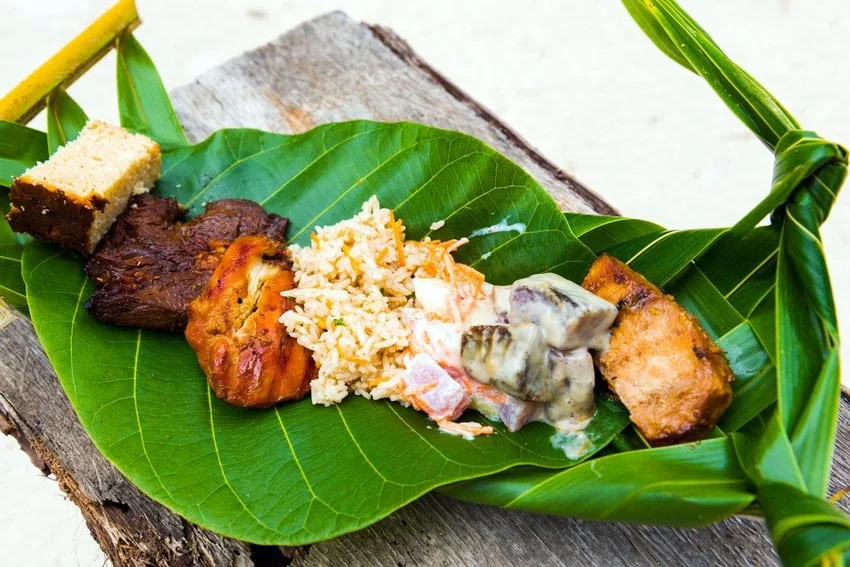Take Me to the Recipes
French Polynesia is a collection of 118 islands and atolls in the South Pacific Ocean, with a rich and diverse history and culture. French Polynesian Cuisine is equally diverse and exciting. Tahiti is the largest island in French Polynesia. This tropical paradise has crystal-clear waters, white sandy beaches, and lush landscapes.
The climate is tropical and warm throughout the year, making it a perfect destination for those seeking sunshine and sea. It is found in the central South Pacific Ocean, French Polynesia’s economy benefits from tourism, pearls, marine resources. It also cultivates vanilla and coconuts.
With a population of around 280,000 people, it boasts a vibrant culture and a cuisine that is as colorful and diverse as its scenery.
French Polynesian Cuisine – Key Takeaways
- French Polynesia cuisine is a blend of traditional Polynesian techniques and French culinary influences.
- Seafood plays a central role, reflecting the islands’ oceanic surroundings.
- Tropical fruits like coconut, banana, and pineapple are staple ingredients.
- Traditional cooking methods include the hima’a, an underground oven similar to the Maori hangi.
- French Polynesia’s cuisine uses fresh, vibrant flavors and the use of local ingredients.
- Poisson cru, a raw fish salad, is the national dish and a must-try for visitors.
Take Me to the Recipes
You may also Enjoy the Following Articles
- North and South American Cuisine – A Culinary Expedition
- Europe Cuisine: Savor the Continent’s Best Culinary Secrets!
- African Cuisine: Discover the Bold Flavors & Global Charm!
- Asian Cuisine Unlock its Secrets – Taste, Health & Global Influence!
- New Zealand Cuisine: A Taste of the Pacific
Where is French Polynesia?


Index of Contents
- Take Me to The Recipes
- Enjoy the Following Articles
- The History and the Effect It Has Had on the French Polynesian Cuisine
- How The Climate and Geography Has Influenced French Polynesian Cuisine
- Understanding the Essence of French Polynesian Cuisine
- What are the health implications of French Polynesian Food
- Traditional French Polynesian Food
- French Polynesia’s National Dish
- French Polynesian Food Recipes You Can Try at Home
- FAQ’s
Savor iconic French Polynesian Food Recipes – Click on each tantalizing picture to open up the Recipe

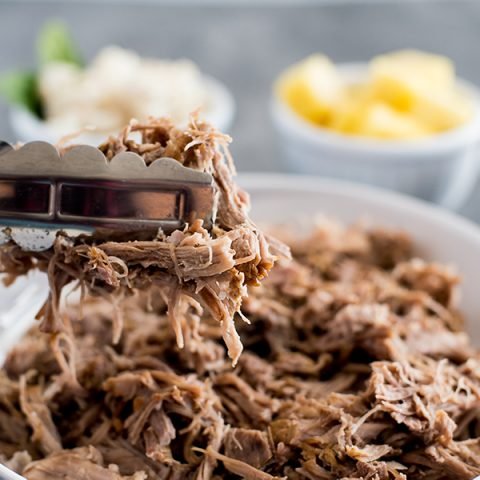
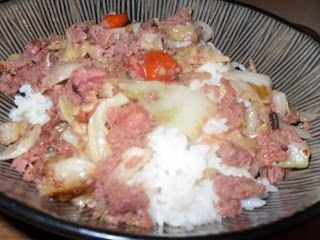
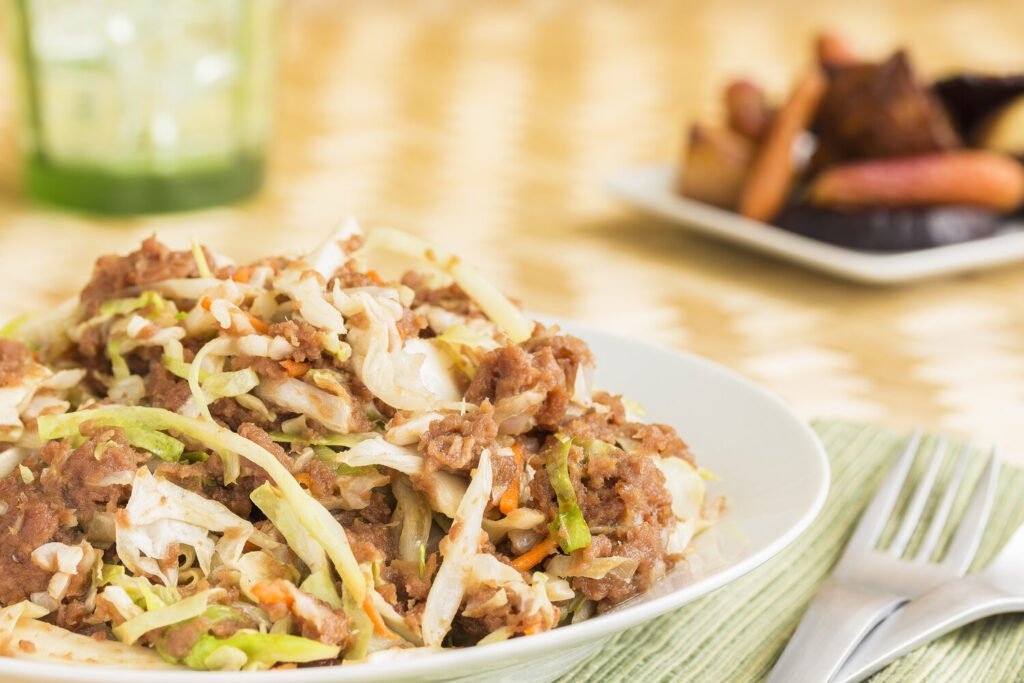





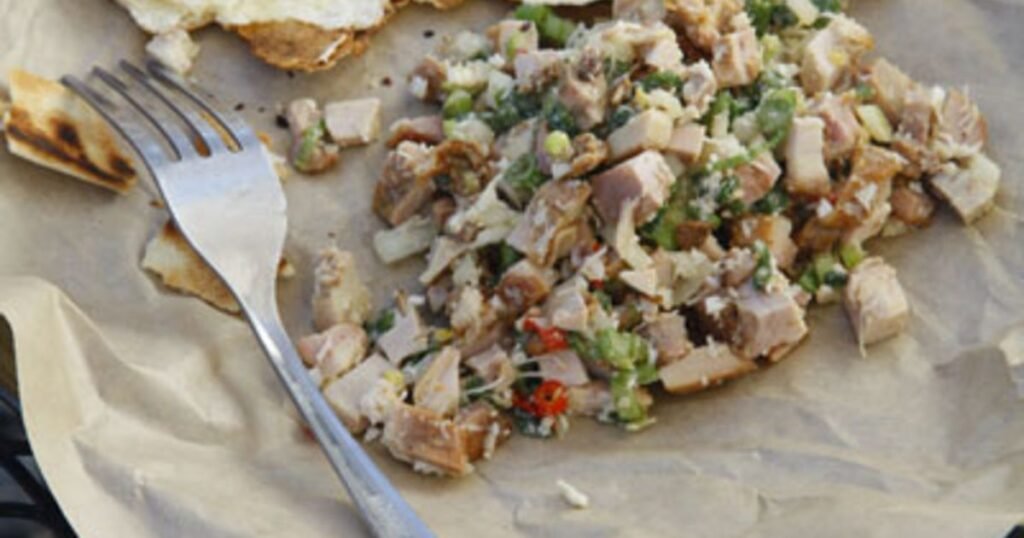
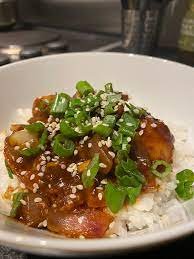
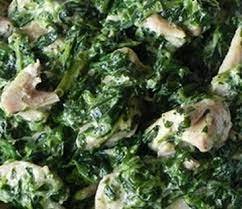
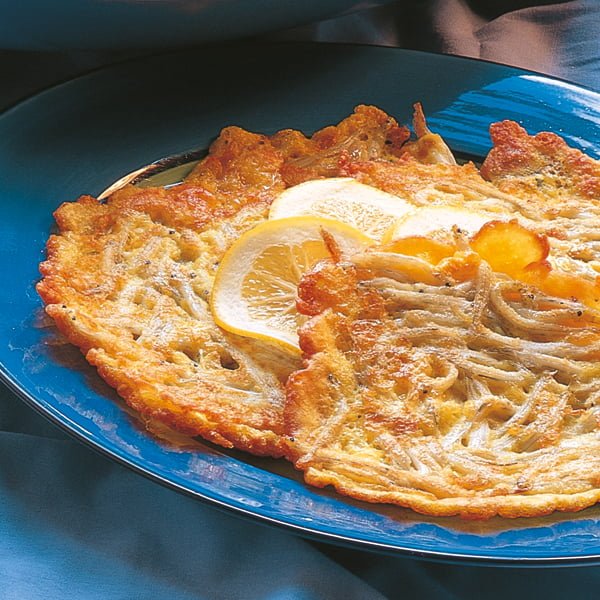
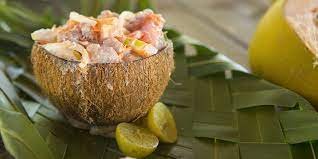
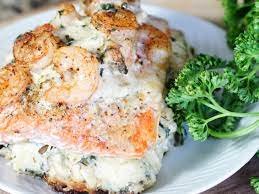
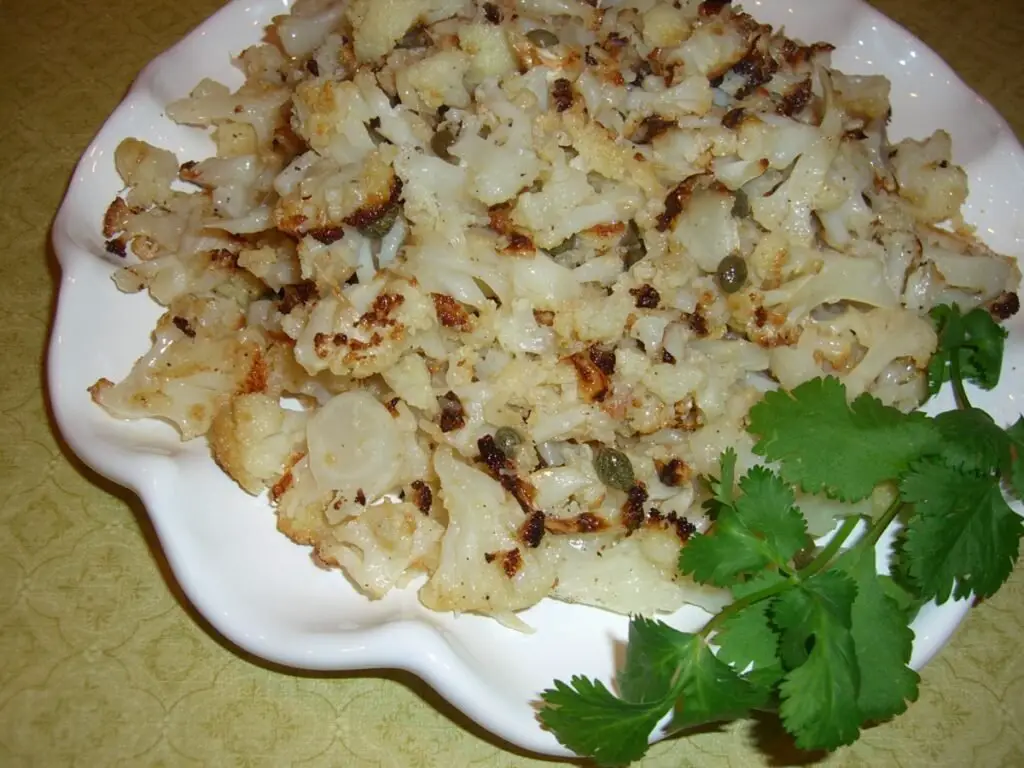

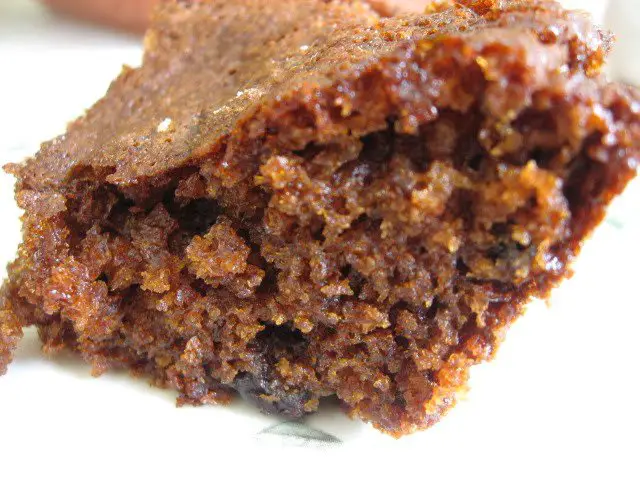
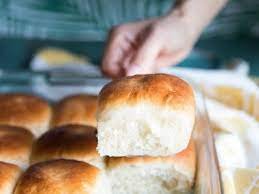

Enjoy the Following Articles
- North and South American Cuisine – A Culinary Expedition
- Europe Cuisine: Savor the Continent’s Best Culinary Secrets!
- African Cuisine: Discover the Bold Flavors & Global Charm!
- Asian Cuisine Unlock its Secrets – Taste, Health & Global Influence!
- New Zealand Cuisine: A Taste of the Pacific
The History and the Effect It Has Had on the French Polynesian Cuisine
The islands were first settled by Polynesians from Southeast Asia, who brought with them their traditions, languages, and culinary practices. They developed a cuisine based on seafood, coconut, breadfruit, taro, and other tropical fruits, as well as a method of cooking food in an earth oven called ahima’a.
The islands were later visited and colonized by Europeans, mainly the French, who introduced new ingredients, such as wheat, dairy, sugar, and wine, as well as new cooking techniques, such as baking, frying, and sautéing.
The French also influenced the political and social structure of the islands, making them an overseas collectivity of France in 1957. The Chinese also had a significant impact on the islands, especially on Tahiti, the most populous and developed island.
They arrived as laborers in the 19th and 20th centuries, and brought with them their cuisine, such as rice, noodles, soy sauce, and stir-fries. They also contributed to the economy and commerce of the islands, opening shops, restaurants, and hotels.
Today, French Polynesian cuisine is a fusion of Polynesian, French, and Chinese influences, offering a variety of dishes and flavors. Some of the most popular dishes include poisson cru, raw fish marinated in lime juice and coconut milk; mahi mahi, a type of fish grilled or baked with a sauce; and fafaru, fermented fish with a strong smell and taste.
Desserts often feature vanilla, a local product, as well as fruits, such as pineapple, mango, and papaya. French Polynesian cuisine reflects the history and the diversity of the islands, as well as their natural resources and climate. It is a cuisine that celebrates the sea, the sun, and the people who live there.
How The Climate and Geography Has Influenced French Polynesian Cuisine
The climate and geography of the islands have influenced the food and cuisine of the people who live there, as well as the visitors and settlers who have arrived over the centuries.
The climate of French Polynesia is tropical, with a hot and humid season from November to April and a cooler season from May to October. The temperatures vary little throughout the year, but they are higher on the northern islands and lower on the southern ones.
The rainfall also varies depending on the location and the season, with some islands receiving more than 3,000 mm (118 in) per year and others less than 1,000 mm (39 in). The islands are occasionally affected by cyclones, especially from December to April.
The Islands have a Diverse Geography
The geography of French Polynesia is diverse, with high volcanic islands, low coral atolls, and lagoons. The islands are rich in natural resources, such as timber, fish, cobalt, and hydropower. The soil is fertile and suitable for growing a variety of crops, such as coconuts, sugarcane, vanilla, coffee, breadfruit, taro, and other tropical fruits.
The climate and geography of French Polynesia have shaped the food and cuisine of the islands in several ways.
- First, they have determined the availability and diversity of ingredients, with seafood, coconut, breadfruit, and fruits being the most common and abundant.
- Second, they have influenced the cooking methods and techniques, such as the use of earth ovens, grilling, baking, frying, and sautéing.
- Third, they have attracted different cultures and influences, such as Polynesian, French, and Chinese, which have added new flavors and dishes to the local cuisine.
French Polynesian food is a fusion of climate, geography, and culture, offering a unique and delicious experience for the palate. Some of the most popular dishes include poisson cru, raw fish marinated in lime juice and coconut milk; mahi mahi, a type of fish grilled or baked with a sauce; and fafaru, fermented fish with a strong smell and taste.
Desserts often feature vanilla, a local product, as well as fruits, such as pineapple, mango, and papaya.
Understanding the Essence of French Polynesian Cuisine
The essence of French Polynesia cuisine lies in its simplicity and the freshness of its ingredients. The traditional diet is rich in seafood, root vegetables like taro, and tropical fruits, all of which are readily available from the surrounding ocean and fertile lands.
French influence is evident in the preparation and presentation of food, bringing a touch of European sophistication to the islands’ dining tables.
What are the health implications of French Polynesian Food
The main ingredients are seafood, coconut, breadfruit, taro, and fruits, which provide protein, healthy fats, carbohydrates, vitamins, and minerals. However, the consumption of processed, imported foods, such as chicken, dairy, sugar, and wheat, has increased over the years, leading to dietary issues and malnutrition in French Polynesia.
According to the World Health Organization, French Polynesia has a high prevalence of noncommunicable diseases, such as obesity, diabetes, cardiovascular diseases, and cancer.
These diseases are linked to unhealthy eating habits, such as excessive intake of calories, fat, salt, and sugar, and low intake of fiber, antioxidants, and phytochemicals.
Moreover, the imported food is often more expensive and less fresh than the local food, affecting the food security and quality of the islands.
French Polynesia needs to promote a balanced and nutritious diet, based on the traditional food of the islands, which is rich in natural and diverse flavors. This would not only improve the health and well-being of the people, but also preserve the culture and environment of the islands.
Traditional French Polynesian Food
French Polynesia is a paradise for food lovers, as it offers a variety of dishes that combine the flavors and ingredients of the islands with the influences of other cultures. The traditional food of French Polynesia is based on seafood, coconut, breadfruit, taro, and fruits, which are abundant and fresh in the tropical climate.
The most famous dish is poisson cru, raw fish marinated in lime juice and coconut milk, which is considered the national dish of Tahiti. Another popular dish is mahi mahi, a type of fish that is grilled or baked with a sauce made from coconut milk, lime juice, ginger, garlic, and tomatoes.
Traditional Cooking Methods
The traditional way of cooking food in French Polynesia is using an earth oven called ahima’a, which is a hole dug in the ground, lined with hot stones and banana leaves, and filled with meat, fish, and vegetables.
The food is then covered with more leaves and soil and left to cook for several hours. This method creates a tender and smoky flavor, and is usually reserved for special occasions, such as weddings, festivals, and ceremonies.
French Polynesia also has a diverse range of desserts, which often feature vanilla, a local product that is highly prized and exported worldwide.
Some of the most common desserts are
- poe, a pudding made from taro, banana, or pumpkin, flavored with vanilla and coconut milk;
- firifiri, a doughnut-like pastry made from flour, yeast, and coconut milk, and fried in oil
- fafaru, a fermented fish with a strong smell and taste, which is usually eaten with breadfruit or taro.
French Polynesian food is a reflection of the history, culture, and nature of the islands, and a delight for the senses. It is a cuisine that celebrates the bounty of the sea and the land, and the diversity of the people who live there.
French Polynesia’s National Dish
The national dish of French Polynesia is poisson cru, which means “raw fish” in French. It is also known as “ia ota in Tahitian”, and is similar to other raw fish dishes found in Polynesia, such as poke in Hawaii and ika mata in the Cook Islands.
Poisson cru is made by marinating raw fish, usually tuna or mahi-mahi, in a mixture of lime juice, coconut milk, and salt. The lime juice “cooks” the fish, giving it a firm and tender texture, while the coconut milk adds creaminess and richness.
The dish is typically served with diced vegetables, such as tomatoes, onions, and cucumbers, and a side of taro or breadfruit. Poisson cru is considered a symbol of the island’s culture and is often served at important celebrations and ceremonies.
Poisson cru is a delicious and refreshing dish that showcases the bounty and diversity of the sea and the land in French Polynesia. It is a dish that celebrates the fusion of flavors and traditions that make the islands unique and special.
Exploring Polynesia’s Ingredients: The Flavors of French Polynesia Cuisine
The main ingredients of French Polynesian cuisine are seafood, coconut, breadfruit, taro, and fruits, which are abundant and fresh in the tropical climate.
Seafood is often eaten raw, marinated, grilled, or baked, and coconut milk is used to add creaminess and richness to many dishes. Breadfruit and taro are starchy staples that can be boiled, mashed, fried, or baked, and fruits are used to add sweetness and acidity to desserts and sauces.
Some of the most famous dishes of French Polynesia are poisson cru, raw fish marinated in lime juice and coconut milk; mahi mahi, a type of fish grilled or baked with a sauce made from coconut milk, lime juice, ginger, garlic, and tomatoes; and fafaru, fermented fish with a strong smell and taste.
These dishes showcase the exotic and diverse flavors of the islands, as well as their natural resources and climate.
French Polynesia cuisine is a fusion of Polynesian, French, and Chinese influences, offering a unique and delicious experience for the palate. It is a cuisine that celebrates the bounty of the sea and the land, and the diversity of the people who live there.
French Polynesian Food Recipes you Can Try at Home
The Food Recipes are a celebration of the islands’ bountiful resources, combining the fresh catch from the sea with the fruits of the land to create dishes that are both nourishing and delightful to the palate.
French Polynesian cuisine – Poisson Cru
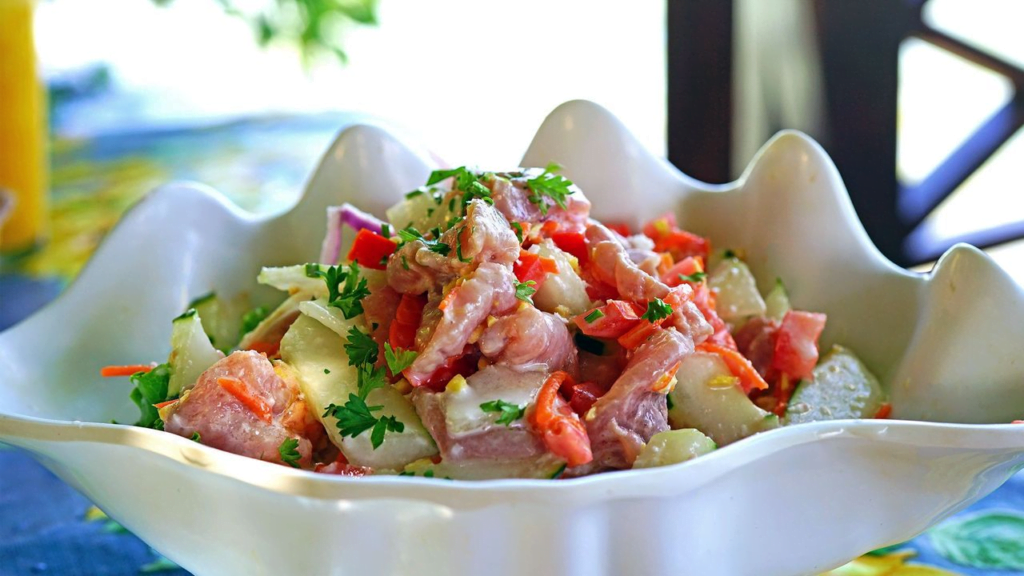
Poisson cru, the quintessential Tahitian dish, is a refreshing raw fish salad marinated in lime juice and coconut milk.
French Polynesian cuisine – Ingredients for Poisson Cru
- Fresh tuna or other sashimi-grade fish
- Lime juice
- Coconut milk
- Cucumber
- Carrot
- Tomato
- Onion
- Salt and pepper
French Polynesian cuisine – How to Prepare Poisson Cru
- Cube the fish and marinate in lime juice for a few minutes.
- Drain the fish and mix with coconut milk and finely sliced vegetables.
- Season with salt and pepper to taste.
Serve Poisson Cru chilled, garnished with additional lime wedges and a sprinkle of chopped green onion. It’s a dish that embodies the spirit of the islands.
A crisp white wine or a tropical cocktail would be the perfect accompaniment to this light and zesty dish.
French Polynesian cuisine – Firi Firi
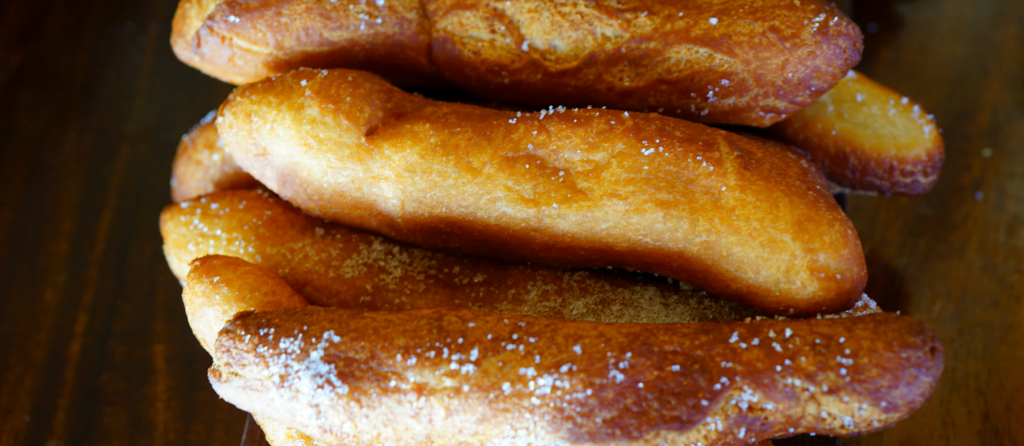
Firi firi, a Tahitian doughnut, is a beloved breakfast item that can also serve as a sweet starter.
French Polynesian cuisine – Ingredients for Firi Firi
- Flour
- Sugar
- Coconut milk
- Yeast
- Water
- Oil for frying
French Polynesian cuisine – How to Prepare Firi Firi
- Combine the ingredients to form a dough and let it rise.
- Roll out the dough, cut into shapes, and fry until golden brown.
- Serve warm, dusted with sugar.
Firi Firi is best enjoyed fresh from the fryer, with a cup of strong coffee or a sweet coconut-infused beverage.
French Polynesian Cuisine – Fafaru

History and Background of Fafaru
Fafaru is a traditional dish from French Polynesia that is often met with intrigue and caution due to its unique preparation method and potent aroma. This dish is a testament to the resourcefulness of the Polynesian people and their deep connection to the sea.
Fafaru takes advantage of the natural preservative properties of seawater and fermentation to create a dish that is both flavorful and long-lasting.
The dish involves marinating fish in a special fermented seawater brine, which imparts a strong, distinctive flavor. The preparation of fafaru reflects the Polynesian tradition of using what the environment provides, and it showcases the bold flavors that can be achieved through fermentation.
While it may be an acquired taste for some, fafaru is a beloved staple in the French Polynesian diet.
Ingredients for Fafaru
- Fresh fish (firm white fish like tuna is commonly used)
- Seawater (or saltwater if seawater is not available)
- Crushed fresh ginger
- Minced garlic
- Chopped onions
- Diced tomatoes
- Lime juice
- Coconut milk (optional, for a milder version)
Recipe for Fafaru
Preparing the Seawater Brine
Collect Seawater
- If you have access to clean, unpolluted seawater, collect it for the most authentic flavor. Otherwise, make a brine by dissolving sea salt in water until it tastes as salty as seawater.
Fermentation Process
- Place the seawater or brine in a clean, non-reactive container.
- Add pieces of fish offcuts or small fish to the water to start the fermentation process.
- Cover the container and let it sit at room temperature for 2-3 days.
- The water will become cloudy and develop a strong, fishy smell.
Preparing the Fafaru
Marinate the Fish
- Clean and cut the fresh fish into serving pieces.
- Place the fish in the fermented seawater brine, ensuring it is completely submerged.
- Let the fish marinate in the brine for at least 4 hours, or overnight for a stronger flavor.
Prepare the Aromatics
- While the fish is marinating, prepare the aromatics. Sauté onions, garlic, and ginger until fragrant and set aside.
Final Preparation
- Remove the fish from the brine and rinse it briefly under cold water to remove excess saltiness.
- In a clean pan, combine the sautéed aromatics with the fish.
- Add diced tomatoes and a squeeze of lime juice.
- If desired, pour coconut milk over the fish to create a richer, milder sauce.
- Gently simmer the fish with the aromatics and coconut milk until it is cooked through.
To Serve
- Serve the fafaru hot, garnished with additional lime wedges and fresh herbs like cilantro or parsley.
- It is traditionally accompanied by steamed white rice or breadfruit.
Presentation and Serving
- Fafaru is typically presented in a communal dish, emphasizing the shared dining experience.
- The strong aroma is a signature characteristic, and the dish is often served outdoors.
Drink Pairing
- A chilled, crisp white wine or a light beer can help balance the robust flavors of fafaru.
Fafaru is a dish that may challenge the palate of those unfamiliar with fermented foods, but it remains a cherished part of French Polynesian cuisine. Its flavors are a bold statement of the islands’ culinary heritage and the ingenuity of its people.
French Polynesian Cuisine – Pahua Taioro

History and Background of Pahua Taioro
Pahua taioro is a traditional French Polynesian dish that showcases the region’s abundant seafood and unique flavor profiles. Pahua refers to the giant clam, a staple in the diet of many Pacific Island cultures, and taioro is a sauce made from fermented coconut milk and sea water.
This dish is a testament to the ingenuity of the Polynesian people, making use of the natural resources available to them in the vast ocean.
The preparation of taioro involves a fermentation process that can take several days, during which the coconut milk combines with sea water and takes on a distinctive tangy flavor. This method of preservation was essential in the days before refrigeration, allowing islanders to keep ingredients fresh in the tropical climate.
French Polynesian Cuisine – Ingredients for Pahua Taioro
- Giant clam meat (pahua)
- Fresh coconut milk
- Sea water (or salt water)
- Onions
- Garlic
- Chili peppers (optional for heat)
- Lime juice
- Fresh coriander (cilantro) for garnish
Recipe for Pahua Taioro
Preparing the Taioro (Fermented Coconut Sauce):
Extract Fresh Coconut Milk
- Grate the flesh of mature coconuts.
- Mix the grated coconut with warm water and squeeze out the milk through a fine cloth or strainer.
Fermentation Process
- Combine the fresh coconut milk with an equal amount of sea water in a clean container.
- Cover the container with a breathable cloth and let it sit in a warm place for 2-3 days to ferment. The mixture should develop a sour aroma.
Preparing the Pahua (Giant Clam)
Clean and Prepare the Clam Meat
- Thoroughly clean the giant clam meat, ensuring all sand and grit are removed.
- Slice the clam meat into thin, bite-sized pieces.
Cooking the Clam
- In a pan, lightly sauté chopped onions, minced garlic, and chili peppers if using, until fragrant.
- Add the clam meat to the pan and cook until just tender. Overcooking can make the clams tough.
Combining with Taioro
- Once the clam meat is cooked, add the fermented taioro sauce to the pan.
- Simmer the mixture on low heat for a few minutes to allow the flavors to meld together.
- Finish with a squeeze of fresh lime juice to enhance the flavors.
To Serve
- Garnish the Pahua taioro with freshly chopped coriander.
- Serve hot, accompanied by steamed rice or taro for a traditional meal.
Presentation and Serving
- Pahua taioro is traditionally served in a communal bowl, celebrating the spirit of sharing that is central to Polynesian culture.
- The dish is often part of a larger feast, where it is enjoyed alongside other local specialties.
Drink Pairing
- A light and fruity white wine, such as a Sauvignon Blanc, pairs well with the delicate flavors of the clam and the tanginess of the taioro sauce.
Pahua taioro is a dish that truly embodies the flavors of French Polynesia, combining the ocean’s bounty with the rich taste of fermented coconut. It’s a culinary experience that connects those who enjoy it to the sea and the traditions of the islands.
French Polynesian cuisine – Po’e

Po’e, a traditional Polynesian pudding, is a staple at any feast and is made with ripe fruit and manioc or arrowroot for thickening.
French Polynesian cuisine – Ingredients for Po’e
- Ripe bananas, pumpkin, or papaya
- Manioc starch or arrowroot
- Brown sugar
- Coconut milk
- Vanilla extract
French Polynesian cuisine – How to Prepare Po’e
- Puree the fruit and mix with sugar, starch, and vanilla.
- Bake until set, then chill in the refrigerator.
- Serve with a generous drizzle of coconut milk.
Po’e is a comforting dessert that’s both sweet and satisfying, perfect for ending a meal on a high note.
A dessert wine or a cup of fragrant tea can complement the sweet, dense flavors of Po’e.
French Polynesian Food – Poulet Fafa

Poulet Fafa: A Taste of French Polynesian Heritage
History and Background: Poulet Fafa is a cherished dish in French Polynesia, reflecting the region’s unique culinary blend of traditional Polynesian and French influences. This hearty chicken and taro leaf stew have roots in the indigenous practices of using local ingredients, enriched over time by the flavors introduced by European settlers.
The dish showcases the harmonious coexistence of indigenous cooking methods and the culinary techniques brought by French colonization.
French Polynesian Food – Poulet Fafa Ingredients:
- 1.5 kg chicken, cut into pieces
- 1 large bunch of taro leaves, cleaned and chopped
- 1 onion, finely chopped
- 2 cloves garlic, minced
- 1 can (400ml) coconut milk
- 2 tablespoons olive oil
- 1 tablespoon soy sauce
- 1 tablespoon lemon juice
- Salt and pepper to taste
French Polynesian Food – Poulet Fafa Recipe:
Preparing Ingredients
- Clean and Chop Taro Leaves:
- Wash taro leaves thoroughly.
- Remove stems and chop leaves into bite-sized pieces.
- Marinate Chicken:
- In a bowl, combine chicken pieces with minced garlic, soy sauce, and lemon juice.
- Allow it to marinate for at least 30 minutes.
Cooking Poulet Fafa
- Sauté Onion:
- In a large pot, heat olive oil over medium heat.
- Sauté chopped onion until translucent.
- Add Marinated Chicken:
- Add the marinated chicken to the pot.
- Cook until the chicken is browned on all sides.
- Introduce Taro Leaves:
- Stir in chopped taro leaves.
- Cook for an additional 5 minutes until the leaves wilt.
- Pour Coconut Milk:
- Pour in the coconut milk, ensuring it covers the chicken and taro leaves.
- Season with salt and pepper to taste.
- Simmer to Perfection:
- Lower the heat and let the stew simmer for 45-60 minutes until the chicken is tender.
- Serve Hot:
- Poulet Fafa is traditionally served hot over steamed rice or with traditional Polynesian bread.
Serving Size: 4-6 people
Estimated Cooking Time: 1 hour and 30 minutes
Calories (per serving): Approximately 480 calories
French Polynesian Food – The Tahitian Raw Fish

The Tahitian Raw Fish: A Culinary Voyage through French Polynesia
History and Background: The Tahitian Raw Fish, known locally as “Poisson Cru,” is a quintessential dish in French Polynesia, reflecting the vibrant flavors of the South Pacific. Originating from the traditional Polynesian practice of marinating fish in lime and coconut milk, this dish has evolved with French influences.
It captures the essence of the islands’ pristine waters and the harmonious coexistence of indigenous and colonial culinary traditions.
French Polynesian Food – The Tahitian Raw Fish Ingredients:
- 500g fresh tuna, cubed
- 1 cucumber, thinly sliced
- 1 large tomato, diced
- 1 small red onion, finely chopped
- 1 bell pepper (any color), diced
- 1 carrot, julienned
- 1 cup coconut milk
- Juice of 4 limes
- 2 tablespoons soy sauce
- Fresh cilantro, chopped
- Salt and pepper to taste
French Polynesian Food – The Tahitian Raw Fish Recipe:
Preparing Ingredients
- Cube Fresh Tuna:
- Cut fresh tuna into bite-sized cubes.
- Chop Vegetables:
- Slice cucumber, dice tomato, chop red onion, dice bell pepper, and julienne the carrot.
Creating the Tahitian Raw Fish
- Marinate Tuna:
- In a bowl, combine tuna cubes with lime juice.
- Let it marinate for at least 15 minutes.
- Combine Ingredients:
- In a large mixing bowl, combine marinated tuna with sliced cucumber, diced tomato, chopped red onion, diced bell pepper, and julienned carrot.
- Add Coconut Milk:
- Pour coconut milk over the mixture.
- Add soy sauce, salt, and pepper to taste.
- Mix and Chill:
- Gently toss the ingredients until well combined.
- Refrigerate for at least 30 minutes to let the flavors meld.
- Serve Fresh:
- Garnish with chopped fresh cilantro before serving.
Serving Size: 4 people
Estimated Cooking Time: 45 minutes (including marination)
Calories (per serving): Approximately 320 calories
French Polynesian Food – Tahitian Corned Beef Recipe

Tahitian Corned Beef: A Fusion of Tradition and Adaptation
History and Background: The Tahitian Corned Beef recipe showcases the culinary adaptability of French Polynesia, blending local ingredients with influences from the colonial era. Introduced during the European exploration, corned beef became a staple in the Tahitian diet.
Over time, the locals incorporated their flavors, creating a unique dish that reflects both the historical importation of canned goods and the indigenous creativity in transforming them into a distinctly Tahitian culinary delight.
French Polynesian Food – Tahitian Corned Beef Ingredients:
- 2 cans (340g each) corned beef
- 1 large onion, finely sliced
- 3 cloves garlic, minced
- 2 large tomatoes, diced
- 2 carrots, peeled and diced
- 2 potatoes, peeled and diced
- 1 cup green beans, trimmed and chopped
- 1 cup coconut milk
- 2 tablespoons vegetable oil
- Salt and pepper to taste
French Polynesian Food – Tahitian Corned Beef Recipe:
Preparing Ingredients
- Open Cans:
- Drain the liquid from the corned beef cans.
- Flake the corned beef with a fork.
- Chop Vegetables:
- Slice the onion, mince garlic, dice tomatoes, peel and dice carrots and potatoes, and chop green beans.
Cooking Tahitian Corned Beef
- Sauté Aromatics:
- In a large pan, heat vegetable oil over medium heat.
- Sauté sliced onions and minced garlic until golden brown.
- Add Vegetables:
- Incorporate diced tomatoes, carrots, potatoes, and green beans into the pan.
- Cook until vegetables are slightly tender.
- Introduce Corned Beef:
- Add the flaked corned beef to the vegetable mixture.
- Stir well to combine.
- Pour Coconut Milk:
- Pour coconut milk into the pan, ensuring even distribution.
- Season with salt and pepper to taste.
- Simmer to Perfection:
- Reduce heat and let the mixture simmer for 20-25 minutes until the flavors meld.
- Serve Hot:
- Tahitian Corned Beef is traditionally served hot, often with rice or bread.
Serving Size: 4-6 people
Estimated Cooking Time: 45 minutes
Calories (per serving): Approximately 380 calories
French Polynesian Food – Strawberry Cake

Strawberry Cake: A Delicate French Polynesian Treat
Background: While not native to French Polynesia, the Strawberry Cake has found its way into the hearts and tables of the locals, showcasing the archipelago’s openness to diverse culinary influences.
Introduced through European colonial connections, this delightful dessert combines the sweetness of ripe strawberries with the tropical flair of the islands, creating a fusion of flavors that captivates both locals and visitors.
French Polynesian Food – Strawberry Cake Ingredients:
- 2 cups fresh strawberries, hulled and sliced
- 2 cups all-purpose flour
- 1 1/2 cups granulated sugar
- 1/2 cup unsalted butter, softened
- 1/2 cup coconut milk
- 3 large eggs
- 2 teaspoons baking powder
- 1 teaspoon vanilla extract
- A pinch of salt
- Powdered sugar for dusting (optional)
French Polynesian Food – Strawberry Cake Recipe:
Preparing Ingredients
- Preheat Oven:
- Preheat the oven to 350°F (175°C).
- Grease and flour a cake pan.
- Hull and Slice Strawberries:
- Hull fresh strawberries and slice them into thin pieces.
Baking Strawberry Cake
- Cream Butter and Sugar:
- In a mixing bowl, cream together softened butter and granulated sugar until light and fluffy.
- Add Eggs and Vanilla:
- Beat in the eggs one at a time, ensuring each is fully incorporated.
- Add vanilla extract and mix well.
- Combine Dry Ingredients:
- In a separate bowl, whisk together flour, baking powder, and a pinch of salt.
- Alternate Mixing:
- Gradually add the dry ingredients to the wet ingredients, alternating with coconut milk.
- Begin and end with the dry ingredients.
- Fold in Strawberries:
- Gently fold in the sliced strawberries into the batter.
- Bake:
- Pour the batter into the prepared cake pan.
- Bake for 30-35 minutes or until a toothpick inserted into the center comes out clean.
- Cool and Serve:
- Allow the cake to cool in the pan for 10 minutes before transferring it to a wire rack.
- Once completely cooled, dust with powdered sugar if desired.
Serving Size: 8-10 people
Estimated Cooking Time: 1 hour
Calories (per serving): Approximately 280 calories
French Polynesian Food – Sweet Blackberry Jam Cake

Sweet Blackberry Jam Cake: A Culinary Ode to French Polynesia’s Bounty
History and Background: The Sweet Blackberry Jam Cake, a beloved dessert in French Polynesia, is a testament to the region’s ability to infuse traditional recipes with locally available ingredients. French Polynesia, with its lush landscapes and tropical fruit abundance, lends its own twist to the global favorite of jam cake.
Blackberries, though not indigenous, have found a welcoming home in the islands, intertwining with the local culinary heritage and creating a delightful confection that captures the essence of French Polynesia.
French Polynesian Food – Sweet Blackberry Jam Cake Ingredients:
- 2 cups all-purpose flour
- 1 cup granulated sugar
- 1 cup blackberry jam
- 1/2 cup unsalted butter, softened
- 1/2 cup coconut milk
- 3 large eggs
- 1 teaspoon baking powder
- 1/2 teaspoon baking soda
- 1/4 teaspoon salt
- 1 teaspoon vanilla extract
- Powdered sugar for dusting (optional)
French Polynesian Food – Sweet Blackberry Jam Cake Recipe:
Preparing Ingredients
- Preheat Oven:
- Preheat the oven to 350°F (175°C).
- Grease and flour a cake pan.
- Bring Ingredients to Room Temperature:
- Ensure the butter, eggs, and coconut milk are at room temperature for even mixing.
Baking Sweet Blackberry Jam Cake
- Cream Butter and Sugar:
- In a mixing bowl, cream together softened butter and granulated sugar until light and fluffy.
- Add Eggs and Vanilla:
- Beat in the eggs one at a time, ensuring each is fully incorporated.
- Add vanilla extract and mix well.
- Combine Dry Ingredients:
- In a separate bowl, whisk together flour, baking powder, baking soda, and salt.
- Alternate Mixing:
- Gradually add the dry ingredients to the wet ingredients, alternating with coconut milk.
- Begin and end with the dry ingredients.
- Fold in Blackberry Jam:
- Gently fold in the blackberry jam into the batter.
- Bake:
- Pour the batter into the prepared cake pan.
- Bake for 40-45 minutes or until a toothpick inserted into the center comes out clean.
- Cool and Serve:
- Allow the cake to cool in the pan for 10 minutes before transferring it to a wire rack.
- Once completely cooled, dust with powdered sugar if desired.
Serving Size: 8-10 people
Estimated Cooking Time: 1 hour
Calories (per serving): Approximately 320 calories
French Polynesian Food – Hawaiian-Style Slow Cooker Kalua Pork

Hawaiian-Style Slow Cooker Kalua Pork: A Taste of Pacific Paradise
History and Background: Hawaiian-Style Slow Cooker Kalua Pork is a culinary homage to the traditional Hawaiian luau, a feast deeply rooted in Polynesian culture. Originating in Hawaii but embraced in French Polynesia, this dish reflects the influence of Pacific migration and cultural exchange.
The preparation involves slow-cooking pork in the style of the traditional Hawaiian imu (underground oven), infusing it with smoky flavors and cultural significance.
French Polynesian Food – Hawaiian-Style Slow Cooker Kalua Pork Ingredients:
- 4-5 lbs pork shoulder or pork butt, bone-in
- 1 tablespoon liquid smoke
- 1 tablespoon sea salt
- 1 tablespoon soy sauce
- 1 tablespoon brown sugar
- 1 teaspoon garlic powder
- 1 teaspoon onion powder
- 1 teaspoon ground black pepper
- Banana leaves or ti leaves (optional, for serving)
- Steamed white rice (for serving)
French Polynesian Food – Hawaiian-Style Slow Cooker Kalua Pork Recipe:
Preparing Ingredients
- Score and Season Pork:
- Score the surface of the pork shoulder with a sharp knife.
- Rub the pork with liquid smoke, sea salt, soy sauce, brown sugar, garlic powder, onion powder, and black pepper.
- Marinate Overnight:
- Place the seasoned pork in a large resealable plastic bag or a covered bowl.
- Refrigerate overnight for flavors to meld.
Slow Cooking Kalua Pork
- Set Up Slow Cooker:
- Place the marinated pork in the slow cooker.
- Cook on Low:
- Cook on low for 8-10 hours or until the pork is tender and easily shreddable.
- Shred the Pork:
- Using forks, shred the pork directly in the slow cooker, mixing it with the accumulated juices.
- Serve:
- Serve the Kalua Pork hot over steamed white rice.
- Optionally, serve in banana leaves or ti leaves for an authentic touch.
- Enjoy the Smoky Goodness:
- The slow-cooked Kalua Pork absorbs the smoky essence, creating a flavorful and tender dish.
Serving Size: 6-8 people
Estimated Cooking Time: 8-10 hours
Calories (per serving): Approximately 450 calories
French Polynesian Food – Moa Fa’Asaina (Samoan Chicken with Coconut Rice)

Moa Fa’Asaina (Samoan Chicken with Coconut Rice): A Culinary Fusion in French Polynesia
History and Background: Moa Fa’Asaina, a traditional Samoan dish, has found a welcoming home in French Polynesia, reflecting the region’s openness to diverse Pacific flavors. Originating in Samoa, this dish marries the succulence of chicken with the richness of coconut, creating a culinary symphony that resonates with the cultural exchanges in the Pacific.
Introduced through migration and trade, Moa Fa’Asaina has become a cherished part of French Polynesian gastronomy.
French Polynesian Food – Moa Fa’Asaina Ingredients:
Chicken:
- 1 whole chicken, cut into pieces
- 2 tablespoons soy sauce
- 1 tablespoon oyster sauce
- 2 tablespoons vegetable oil
- 1 onion, finely chopped
- 3 cloves garlic, minced
- 1-inch ginger, grated
- 1 cup coconut milk
- 1 cup chicken broth
- Salt and pepper to taste
Coconut Rice:
- 2 cups jasmine rice
- 2 cups coconut milk
- 1 cup water
- 1 teaspoon salt
French Polynesian Food – Moa Fa’Asaina Recipe:
Preparing Ingredients
- Marinate Chicken:
- In a bowl, combine chicken pieces with soy sauce and oyster sauce.
- Let it marinate for at least 30 minutes.
- Prepare Coconut Rice:
- Rinse jasmine rice under cold water until the water runs clear.
- In a rice cooker, combine rice, coconut milk, water, and salt. Cook according to the rice cooker instructions.
Cooking Moa Fa’Asaina
- Sauté Aromatics:
- In a large pot, heat vegetable oil over medium heat.
- Sauté chopped onion, minced garlic, and grated ginger until fragrant.
- Brown Chicken:
- Add the marinated chicken pieces to the pot.
- Brown the chicken on all sides.
- Pour Coconut Milk and Broth:
- Pour in coconut milk and chicken broth.
- Season with salt and pepper to taste.
- Simmer to Perfection:
- Lower the heat and let the chicken simmer for 30-40 minutes until fully cooked and tender.
- Serve Hot:
- Serve the Moa Fa’Asaina hot over a bed of coconut rice.
Serving Size: 4-6 people
Estimated Cooking Time: 1 hour
Calories (per serving): Approximately 560 calories
French Polynesian Food – Pani Popo (Samoan Coconut Bread Rolls)

Pani Popo (Samoan Coconut Bread Rolls): A Taste of Island Indulgence in French Polynesia
History and Background: Pani Popo, originating from Samoa, has become a cherished delicacy in French Polynesia, showcasing the archipelago’s fondness for tropical ingredients. These sweet coconut bread rolls, bathed in a luscious coconut milk sauce, exemplify the fusion of Samoan culinary traditions and the flavors embraced in the islands of French Polynesia.
Introduced through cultural exchanges and shared Pacific heritage, Pani Popo has found a place on the tables of locals and visitors alike.
French Polynesian Food – Pani Popo Ingredients:
Bread Rolls:
- 4 cups all-purpose flour
- 1/2 cup granulated sugar
- 1 packet (2 1/4 tsp) active dry yeast
- 1 cup warm water
- 1/2 cup coconut milk
- 1/4 cup unsalted butter, melted
- 1/2 teaspoon salt
Coconut Sauce:
- 1 can (400ml) coconut milk
- 1/2 cup granulated sugar
- 1/2 teaspoon vanilla extract
- A pinch of salt
French Polynesian Food – Pani Popo Recipe:
Preparing Ingredients
- Activate Yeast:
- In a bowl, dissolve the sugar in warm water and sprinkle yeast over the top.
- Let it sit for 5-10 minutes until frothy.
- Prepare Dough:
- In a large mixing bowl, combine activated yeast mixture, flour, coconut milk, melted butter, and salt.
- Knead the dough until smooth and elastic.
Making Pani Popo
- Proof the Dough:
- Place the dough in a lightly oiled bowl, cover with a damp cloth, and let it rise in a warm place for 1-2 hours, or until doubled in size.
- Shape Rolls:
- Punch down the dough and divide it into small portions.
- Shape each portion into rolls and place them in a baking dish.
- Prepare Coconut Sauce:
- In a saucepan, combine coconut milk, sugar, vanilla extract, and a pinch of salt.
- Heat over medium heat until the sugar dissolves.
- Pour Coconut Sauce:
- Pour the coconut sauce over the shaped rolls in the baking dish.
- Bake:
- Bake in a preheated oven at 350°F (175°C) for 25-30 minutes or until the rolls are golden brown.
- Serve Warm:
- Serve Pani Popo warm, allowing the rolls to soak up the delicious coconut sauce.
Serving Size: 8-10 people
Estimated Cooking Time: 2.5 hours (including rising time)
Calories (per serving): Approximately 220 calories
French Polynesian Food – Whitebait Fritters

Whitebait Fritters: A Coastal Culinary Tradition in French Polynesia
History and Background: Whitebait fritters, a coastal delicacy in French Polynesia, pay homage to the abundant marine life surrounding the islands. Originating from the indigenous practices of harvesting small, tender fish, this dish reflects the historical reliance on coastal resources for sustenance.
Over time, with the influence of various cultures, whitebait fritters have become a beloved treat, embodying the region’s connection to the sea and its rich culinary heritage.
French Polynesian Food – Whitebait Fritters Ingredients:
- 1 cup whitebait
- 2 eggs
- 1/4 cup all-purpose flour
- 1/4 cup chopped fresh parsley
- 1/4 cup chopped chives
- Salt and pepper to taste
- Butter or oil for frying
- Lemon wedges for serving
French Polynesian Food – Whitebait Fritters Recipe:
Preparing Ingredients
- Clean Whitebait:
- Rinse the whitebait under cold water and gently pat them dry with a paper towel.
- Whisk Eggs:
- In a bowl, whisk the eggs until well beaten.
Making Whitebait Fritters
- Combine Ingredients:
- In a mixing bowl, combine the whitebait, beaten eggs, all-purpose flour, chopped parsley, chopped chives, salt, and pepper. Mix well.
- Heat Butter or Oil:
- In a frying pan, heat a generous amount of butter or oil over medium heat.
- Fry Fritters:
- Spoon portions of the whitebait mixture into the hot pan, forming small fritters.
- Cook until golden brown on each side, ensuring the whitebait is fully cooked.
- Drain Excess Oil:
- Place the cooked fritters on a paper towel-lined plate to absorb any excess oil.
- Serve Hot:
- Serve the whitebait fritters hot, accompanied by lemon wedges for a burst of freshness.
Serving Size: 2-4 people
Estimated Cooking Time: 15-20 minutes
Calories (per serving): Approximately 180 calories
French Polynesian Food – Malasadas
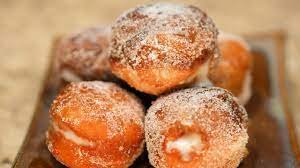
Malasadas: Portuguese Sweetness in French Polynesia
History and Background: Malasadas, originally brought to Hawaii by Portuguese immigrants, have become a beloved treat in French Polynesia, reflecting the archipelago’s multicultural influences. The origins of these sweet, deep-fried dough balls trace back to the Portuguese celebration of Mardi Gras.
Over time, the recipe has evolved, incorporating tropical flavors and becoming an integral part of French Polynesian culinary traditions, offering a delightful taste of both European and Pacific influences.
French Polynesian Food – Malasadas Ingredients:
- 4 cups all-purpose flour
- 1/2 cup granulated sugar
- 1 packet (2 1/4 tsp) active dry yeast
- 1 cup warm milk
- 1/4 cup unsalted butter, melted
- 3 large eggs
- 1/2 teaspoon salt
- Vegetable oil for frying
- Powdered sugar for coating
French Polynesian Food – Malasadas Recipe:
Preparing Ingredients
- Activate Yeast:
- In a bowl, dissolve sugar in warm milk and sprinkle yeast over the top.
- Let it sit for 5-10 minutes until frothy.
- Prepare Dough:
- In a large mixing bowl, combine activated yeast mixture, flour, melted butter, eggs, and salt.
- Knead the dough until smooth and elastic.
Making Malasadas
- Proof the Dough:
- Place the dough in a lightly oiled bowl, cover with a damp cloth, and let it rise in a warm place for 1-2 hours, or until doubled in size.
- Punch Down and Shape:
- Punch down the dough and divide it into small portions.
- Shape each portion into balls and place them on a floured surface.
- Rise Again:
- Cover the shaped dough balls and let them rise for another 30 minutes.
- Heat Oil:
- Heat vegetable oil in a deep fryer or large, deep pan to 350°F (175°C).
- Fry Malasadas:
- Carefully place the dough balls into the hot oil.
- Fry until golden brown on both sides.
- Coat in Powdered Sugar:
- While still warm, roll the malasadas in powdered sugar until fully coated.
- Serve Warm:
- Malasadas are best enjoyed warm, straight from the fryer.
Serving Size: 8-10 people
Estimated Cooking Time: 2.5 hours (including rising time)
Calories (per serving): Approximately 220 calories
French Polynesian Food – Kelaguen Mannok (Chamorro-Style Chicken Salad)

Kelaguen Mannok: Chamorro Culinary Heritage in French Polynesia
History and Background: Kelaguen Mannok, a traditional dish from the Chamorro people of Guam, has found its way to French Polynesia, reflecting the Pacific’s rich tapestry of culinary exchange. Originating in Guam, this dish is a celebration of local flavors and cultural identity.
The dish typically features grilled chicken, coconut, and citrusy flavors, showcasing the harmonious blend of indigenous Chamorro ingredients. Over time, it has become a beloved part of French Polynesian cuisine, illustrating the interconnectedness of Pacific cultures.
French Polynesian Food – Kelaguen Mannok Ingredients:
Chicken Marinade:
- 2 lbs boneless, skinless chicken thighs
- 1 cup coconut milk
- 1/2 cup soy sauce
- 1/2 cup lemon juice
- 1/4 cup green onions, finely chopped
- 2 cloves garlic, minced
- Salt and pepper to taste
Kelaguen:
- 2 cups freshly grated coconut
- 1 cup green onions, finely chopped
- 1 cup lemon juice
- 1 tablespoon red pepper flakes (optional)
- Salt and pepper to taste
French Polynesian Food – Kelaguen Mannok Recipe:
Preparing Chicken Marinade
- Marinate Chicken:
- In a bowl, combine chicken thighs with coconut milk, soy sauce, lemon juice, chopped green onions, minced garlic, salt, and pepper.
- Let it marinate for at least 1-2 hours.
Grilling Chicken
- Grill Chicken:
- Preheat a grill or grill pan over medium-high heat.
- Grill the marinated chicken thighs until fully cooked and have a nice char on the outside.
- Allow the grilled chicken to rest for a few minutes.
Making Kelaguen
- Shred Chicken:
- Shred the grilled chicken into small pieces.
- Combine Ingredients:
- In a large bowl, combine the shredded chicken with freshly grated coconut, chopped green onions, lemon juice, and red pepper flakes if using.
- Mix well and season with salt and pepper to taste.
- Chill and Serve:
- Refrigerate the Kelaguen Mannok for at least 30 minutes before serving to allow the flavors to meld.
- Serve chilled and enjoy this refreshing Chamorro-style chicken salad.
Serving Size: 4-6 people
Estimated Cooking Time: 30 minutes (plus marinating time)
Calories (per serving): Approximately 380 calories
French Polynesian Food – Huli Huli Chicken

Huli Huli Chicken: Grilled Hawaiian Goodness in French Polynesia
History and Background: Huli Huli Chicken, a Hawaiian barbecue classic, has made its mark in French Polynesia, exemplifying the Pacific’s culinary crosscurrents. Originating in Hawaii, this dish’s name, “huli huli,” refers to the method of constantly turning the chicken on the grill.
Originally cooked for fundraising events, Huli Huli Chicken has become a symbol of outdoor gatherings and tropical feasts. In French Polynesia, it has found a home, adapting to local flavors and becoming a favorite at beachside celebrations.
French Polynesian Food – Huli Huli Chicken Ingredients:
- 4 lbs chicken thighs, bone-in and skin-on
- 1 cup soy sauce
- 1/2 cup ketchup
- 1/2 cup pineapple juice
- 1/4 cup brown sugar
- 1/4 cup rice vinegar
- 1/4 cup honey
- 3 cloves garlic, minced
- 1 tablespoon fresh ginger, grated
- 1 teaspoon sesame oil
- Green onions and sesame seeds for garnish (optional)
French Polynesian Food – Huli Huli Chicken Recipe:
Marinating Chicken
- Prepare Marinade:
- In a bowl, whisk together soy sauce, ketchup, pineapple juice, brown sugar, rice vinegar, honey, minced garlic, grated ginger, and sesame oil.
- Marinate Chicken:
- Place chicken thighs in a large resealable bag or shallow dish.
- Pour half of the marinade over the chicken, reserving the rest for basting.
- Marinate in the refrigerator for at least 2 hours, or preferably overnight.
Grilling Huli Huli Chicken
- Preheat Grill:
- Preheat the grill to medium-high heat.
- Grill Chicken:
- Remove chicken from the marinade, letting excess drip off.
- Grill chicken thighs, turning occasionally and basting with reserved marinade, until fully cooked with a nice char, about 20-25 minutes.
Serving Huli Huli Chicken
- Garnish and Serve:
- Garnish Huli Huli Chicken with chopped green onions and sesame seeds if desired.
- Serve hot, capturing the essence of Hawaiian barbecue in every juicy bite.
Serving Size: 6-8 people
Estimated Cooking Time: 25 minutes (plus marinating time)
Calories (per serving): Approximately 380 calories
French Polynesian Food – Samoan Spice Cake

Samoan Spice Cake: A Fusion of Flavors from the Pacific Isles
History and Background: Samoan Spice Cake, a delightful dessert, reflects the influences of Polynesian culture and the islands’ rich culinary tapestry. Samoa, nestled in the heart of the Pacific, brings forth a unique blend of indigenous flavors and international influences.
This spice cake, with its aromatic spices and tropical ingredients, pays homage to the diverse history of Samoa, showcasing the island’s ability to weave traditional elements into contemporary cuisine.
French Polynesian Food – Samoan Spice Cake Ingredients:
Cake:
- 2 cups all-purpose flour
- 1 1/2 teaspoons baking powder
- 1 teaspoon baking soda
- 1 teaspoon ground cinnamon
- 1/2 teaspoon ground ginger
- 1/2 teaspoon ground nutmeg
- 1/4 teaspoon ground cloves
- 1/2 cup unsalted butter, softened
- 1 cup granulated sugar
- 2 large eggs
- 1 teaspoon vanilla extract
- 1 cup buttermilk
Frosting:
- 1/2 cup unsalted butter, softened
- 2 cups powdered sugar
- 1 teaspoon vanilla extract
- 2 tablespoons coconut milk
French Polynesian Food – Samoan Spice Cake Recipe:
Preparing the Cake
- Preheat Oven:
- Preheat the oven to 350°F (175°C).
- Grease and flour two 9-inch round cake pans.
- Combine Dry Ingredients:
- In a bowl, whisk together flour, baking powder, baking soda, cinnamon, ginger, nutmeg, and cloves.
- Cream Butter and Sugar:
- In a separate bowl, cream together softened butter and granulated sugar until light and fluffy.
- Add Eggs and Vanilla:
- Beat in the eggs one at a time, ensuring each is fully incorporated.
- Add vanilla extract and mix well.
- Alternate Mixing:
- Gradually add the dry ingredients to the wet ingredients, alternating with buttermilk.
- Begin and end with the dry ingredients.
- Bake:
- Divide the batter evenly between the prepared pans.
- Bake for 25-30 minutes or until a toothpick inserted into the center comes out clean.
Making the Frosting
- Prepare Frosting:
- In a bowl, beat together softened butter, powdered sugar, vanilla extract, and coconut milk until smooth and creamy.
- Frost the Cake:
- Once the cakes have cooled, frost the top of one cake layer.
- Place the second layer on top and frost the entire cake.
- Serve and Enjoy:
- Slice and serve the Samoan Spice Cake, savoring the harmonious blend of spices and sweetness.
Serving Size: 10-12 people
Estimated Cooking Time: 30 minutes
Calories (per serving): Approximately 320 calories
French Polynesian Food – Kapisi Pulu (Simmered Corned Beef)

Kapisi Pulu: A Savory Tradition from French Polynesia
History and Background: Kapisi Pulu, a dish of simmered corned beef, embodies the flavors and traditions of French Polynesia. Rooted in the influence of European culinary elements, this dish has evolved into a local favorite, capturing the essence of the Pacific Islands.
With a unique blend of indigenous ingredients and a nod to global tastes, Kapisi Pulu reflects the diverse cultural tapestry that defines the culinary landscape of French Polynesia.
French Polynesian Food – Kapisi Pulu Ingredients:
- 2 lbs corned beef, brisket or round cut
- 2 tablespoons vegetable oil
- 1 large onion, thinly sliced
- 3 cloves garlic, minced
- 2 bay leaves
- 1 teaspoon whole black peppercorns
- 1 teaspoon ground turmeric
- 4 cups coconut milk
- 4 cups water
- 1 large bunch taro leaves, cleaned and chopped (substitute with spinach or kale if taro leaves are unavailable)
- Salt and pepper to taste
- Cooked taro or breadfruit for serving
French Polynesian Food – Kapisi Pulu Recipe:
Preparing Ingredients
- Rinse Corned Beef:
- Rinse the corned beef under cold water to remove excess salt.
- Chop Vegetables:
- Thinly slice the onion, mince the garlic, and chop the taro leaves.
Making Kapisi Pulu
- Sear Corned Beef:
- In a large pot, heat vegetable oil over medium-high heat.
- Sear the corned beef on all sides until browned.
- Saute Aromatics:
- Add sliced onions and minced garlic to the pot.
- Saute until the onions are soft and translucent.
- Simmer with Spices:
- Add bay leaves, whole black peppercorns, and ground turmeric to the pot.
- Pour in coconut milk and water, ensuring the corned beef is submerged.
- Simmer Corned Beef:
- Cover the pot and let the corned beef simmer over low heat for 1.5 to 2 hours or until tender.
- Add Taro Leaves:
- Stir in the chopped taro leaves and continue simmering for an additional 15-20 minutes until the leaves are tender.
- Season and Serve:
- Season with salt and pepper to taste.
- Serve Kapisi Pulu hot with cooked taro or breadfruit.
Serving Size: 6-8 people
Estimated Cooking Time: 2.5 – 3 hours
Calories (per serving): Approximately 420 calories
French Polynesian Food – Shrimp & Spinach Stuffed Salmon

Shrimp & Spinach Stuffed Salmon: Oceanic Elegance from French Polynesia
History and Background: Shrimp & Spinach Stuffed Salmon, a culinary gem from French Polynesia, beautifully blends the bounty of the ocean with the elegance of seafood. As an archipelago surrounded by rich marine life, French Polynesia showcases its love for fresh and flavorful seafood through this dish.
The melding of succulent shrimp and vibrant spinach within a salmon fillet pays homage to the Pacific’s aquatic abundance and the islanders’ culinary ingenuity.
French Polynesian Food – Shrimp & Spinach Stuffed Salmon Ingredients:
Shrimp & Spinach Stuffing:
- 1 cup cooked shrimp, chopped
- 1 cup fresh spinach, chopped
- 1/4 cup cream cheese
- 2 cloves garlic, minced
- 1 tablespoon olive oil
- Salt and pepper to taste
Salmon:
- 4 salmon fillets, skin-on
- 2 tablespoons olive oil
- Lemon wedges for serving
French Polynesian Food – Shrimp & Spinach Stuffed Salmon Recipe:
Preparing the Shrimp & Spinach Stuffing
- Cook Shrimp:
- Cook shrimp and chop into small pieces.
- Saute Garlic and Spinach:
- In a pan, heat olive oil and sauté minced garlic until fragrant.
- Add chopped spinach and cook until wilted.
- Combine Ingredients:
- In a bowl, mix cooked shrimp, sautéed spinach, and cream cheese.
- Season with salt and pepper to taste.
Preparing the Salmon
- Preheat Oven:
- Preheat the oven to 375°F (190°C).
- Prepare Salmon Fillets:
- Make a horizontal slit along the side of each salmon fillet, creating a pocket for the stuffing.
- Stuff Salmon:
- Stuff each salmon fillet with the shrimp and spinach mixture.
- Season and Sear:
- Season the outside of the salmon with salt and pepper.
- In an oven-safe skillet, heat olive oil over medium-high heat.
- Sear the salmon fillets, skin-side down, for 2-3 minutes until golden.
- Bake:
- Transfer the skillet to the preheated oven and bake for 12-15 minutes or until the salmon is cooked through.
- Serve Hot:
- Serve the Shrimp & Spinach Stuffed Salmon hot, garnished with lemon wedges.
Serving Size: 4 people
Estimated Cooking Time: 25 minutes
Calories (per serving): Approximately 380 calories
French Polynesian Food – Whole Roasted Cauliflower with Olive Oil and Capers

Whole Roasted Cauliflower with Olive Oil and Capers: A Vegetarian Delight from French Polynesia
History and Background: Whole Roasted Cauliflower with Olive Oil and Capers is a culinary creation that beautifully showcases the simplicity and flavors of French Polynesian vegetarian cuisine. In a region where fresh and vibrant produce is abundant, this dish elevates cauliflower to a centerpiece with the infusion of olive oil and the briny touch of capers.
Rooted in the island’s commitment to fresh and wholesome ingredients, this roasted cauliflower dish captures the essence of Pacific vegetarian gastronomy.
Whole Roasted Cauliflower with Olive Oil and Capers Ingredients:
- 1 whole cauliflower, leaves removed
- 1/4 cup olive oil
- 2 tablespoons capers, drained
- 2 cloves garlic, minced
- 1 teaspoon dried thyme
- Salt and black pepper to taste
- Lemon wedges for serving
- Fresh parsley for garnish (optional)
Whole Roasted Cauliflower with Olive Oil and Capers Recipe:
Preparing the Cauliflower
- Preheat Oven:
- Preheat the oven to 400°F (200°C).
- Prepare Cauliflower:
- Trim the leaves from the cauliflower, leaving the core intact.
- Wash and pat the cauliflower dry.
Making the Roasted Cauliflower
- Make the Olive Oil Mixture:
- In a small bowl, mix olive oil, drained capers, minced garlic, dried thyme, salt, and black pepper.
- Coat Cauliflower:
- Place the cauliflower on a baking sheet.
- Generously brush the cauliflower with the olive oil mixture, ensuring it’s well coated.
- Roast:
- Roast the cauliflower in the preheated oven for 45-50 minutes, or until the exterior is golden and the cauliflower is tender when pierced with a knife.
- Baste and Garnish:
- Periodically baste the cauliflower with the olive oil mixture while roasting to enhance flavor.
- Optionally, garnish with fresh parsley.
- Serve Hot:
- Transfer the Whole Roasted Cauliflower to a serving platter.
- Serve hot with lemon wedges on the side.
Serving Size: 4 people
Estimated Cooking Time: 50 minutes
Calories (per serving): Approximately 180 calories
Conclusion
French Polynesia’s cuisine is a vibrant tapestry that reflects the islands’ rich cultural heritage and the abundance of their natural resources. From the ocean’s bounty to the fertile lands, the food is a celebration of life in the Pacific.
FAQ’s
What is the national dish of French Polynesia?
Poisson cru is considered the national dish of French Polynesia, a must-try for any visitor.
Is French Polynesia cuisine influenced by other cultures?
Yes, French Polynesia’s cuisine has been influenced by French culinary traditions and other cultures over the years.
Can you find vegetarian options in French Polynesia cuisine?
Yes, there are many dishes made with vegetables and fruits that cater to vegetarians.
What is a traditional cooking method in French Polynesia?
The hima’a, an underground oven, is a traditional cooking method used for communal feasts.
What are some typical ingredients in French Polynesia cuisine?
Seafood, coconut, taro, breadfruit, and tropical fruits are typical ingredients.
Are there any French Polynesia desserts?
Yes, desserts like Po’e and coconut bread are popular sweet treats in French Polynesia.

